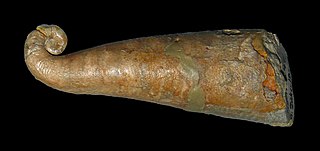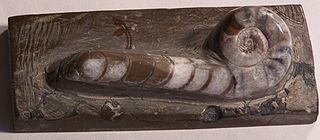
Lituites is an extinct nautiloid genus from the Middle Ordovician and type for the Lituitidae that in some more recent taxonomies has been classified with the orthocerids and listed under the order Lituitida. Fossils have been found in New York, Argentina, Norway, Sweden, Estonia, and China.

The gastropod shell is part of the body of a gastropod or snail, a kind of mollusc. The shell is an exoskeleton, which protects from predators, mechanical damage, and dehydration, but also serves for muscle attachment and calcium storage. Some gastropods appear shell-less (slugs) but may have a remnant within the mantle, or the shell is reduced such that the body cannot be retracted within (semi-slug). Some snails also possess an operculum that seals the opening of the shell, known as the aperture, which provides further protection. The study of mollusc shells is known as conchology. The biological study of gastropods, and other molluscs in general, is malacology. Shell morphology terms vary by species group.

Aphetoceras is a genus of tarphycerid cephalopod within the Estonioceratidae; loosely coiled without an impression along the dorsal margin; early whorls barely reaching, separating then diverging in the final mature whorl; weakly ribbed in some. The cross section of Aphetoceras is higher than wide, making it compressed in form. The dorsum, along the inner curve, is more broadly rounded than the venter which lies along the outer curve. The siphuncle is relatively large, located near but not at the ventral margin; lined with secondary deposits. Chambers are empty.

Trocholites is a tarphycerid genus in the family Trocholitidae from the Middle and Late Ordovician with a gradually expanding, weakly ribbed shell; whorls in contact, dorsum slightly impressed; cross section depressed, venter and sides rounded; siphuncle close to but not at the dorsal margin.

Discoceras is an extinct marine cephalopod mollusk, a member of the Trocholitidae in the Tarphycerida. It is distinct from Discosorus, It is characterized by closely coiled, gradually expanding shells with a subquadrate cross section, that may be ribbed or smooth. The sides are broadly rounded; the venter is wide and slightly rounded. The maximum width is slightly dorsal of the middle. The dorsum has a slight to moderate impression. The siphuncle starts off central for the first half whorl then becomes marginodorsal in the succeeding two whorls, then subdorsal at maturity. As with Trocholites, the dorsal siphuncle in Discoceras probably indicates an orientation during life that places the back of the living chamber high in the shell.
The Tarphycerida were the first of the coiled cephalopods, found in marine sediments from the Lower Ordovician to the Middle Devonian. Some, such as Aphetoceras and Estonioceras, are loosely coiled and gyroconic; others, such as Campbelloceras, Tarphyceras, and Trocholites, are tightly coiled, but evolute with all whorls showing. The body chamber of tarphycerids is typically long and tubular, as much as half the length of the containing whorl in most, greater than in the Silurian Ophidioceratidae. The Tarphycerida evolved from the elongated, compressed, exogastric Bassleroceratidae, probably Bassleroceras, around the end of the Gasconadian through forms like Aphetoceras. Close coiling developed rather quickly, and both gyroconic and evolute forms are found in the early middle Canadian.
Tarphyeras is a genus of tarphyceratid with whorls rounded in cross section, having a deeply impressed dorsum and a ventral to subcentral siphuncle, known from the Lower Ord of North America. It differs from Campbelloceras in that Campbelloceras is only slightly impressed, from Centrotarphyceras in that Centrotarphyceras is subquadrate and has a central siphuncle, and from Trocholites in that although Trocholites is subcircular in cross section, the siphuncle is subdorsal.
Campbelloceras is a tarphyceratid nautiloid known from the Lower Ordovician, Upper Canadian Epoch of North America, where it is widespread. Campbelloceras was named by Ulrich and Foerste in 1936.
Beekmanoceras is a small cephalopod from the Middle Canadian Epoch of New York with a loosely coiled, gyroconic, shell in which the whorls are not in contact and the siphuncle is on the inner or concave side of the whorl. Furnish and Glenister (1964) placed Beekmanoceras in the Trocholitidae (Tarphycerida), interpreting the curvature to be ventral side convex, i.e. exogastastric and the siphuncle to be dorsal. Flower (1964) included Beekmanoceras in the Ellesmeroceratidae believing the siphuncle to be ventral and the curvature to be endogastric with the ventral side concave.
Litoceras is a trocholitid (Tarphycerida) genus that has been found in the Lower and Middle Ordovician of Newfoundland. Whorls in Litoceras have a broadly rounded cross section with its width greater than its height. Litoceras somewhat resembles the tarphyceratid Pionoceras from the same time, except for the siphuncle being dorsal and in the center.
The Tarphyceratidae are tightly coiled, evolute Tarphycerida with ventral siphuncles. The dorsum is characteristically impressed where the whorl presses against the venter of the previous. The Tarphyceratidae are derived from Bassleroceras or possibly from some member of the Estonioceratidae.
The Trocholitidae are Tarphycerida with whorls in close contact as with the Tarphyceratidae, but in which the siphuncle, similar in structure, becomes dorsal. The Trocholitidae are derived from the Tarphyceratidae, perhaps from different tarphyceratids.

Ancistroceras is one of the two ancestral lituitids from the late Early Ordovician (Arenigian). The other being Holmiceras.
Holmiceras is one of two ancestral lituitids from the late Early Ordovician (Arenigian). The other being Ancistroceras.

The Lituitidae are a family of evolved tarphycerids characterized by a long orthoconic section that follows a coiled juvenile portion at the apex, along with a generally tubular siphuncle, which like that of the barrandeocerids is composed of thin connecting rings.
Angelinoceras is a genus of lituitids from the Middle Ordovician that starts off with an open spiral of about 1.5 strongly compressed whorls followed by a straight orthoconic section that continues to expand for a length about equal to the diameter of the coiled portion before retaining a more or less consistent diameter. The juvenile spiral portion has a deep indentation on the ventral side of the aperture for the water-jet funnel, known as a hyponomic sinus, that becomes broad and shallow in the straight-shelled adult portion.

The Estonioceratidae are a family of loosely coiled tarphycerids in which the inner side of the whorls, which forms the dorsum, is rounded or flat with no impression, and in which the siphuncle, composed of thick tubular segments, is located ventrally. The Estonioceratidae seem to form a link between the ancestral Bassleroceratidae and the more tightly coiled Tarphyceratidae.
Ophioceras is a genus of closely coiled tarphycerid nautiloid cephalopods, the sole representatives of the family Ophidioceratidae, characterized by an evolute shell with narrow, subrounded, annulated whorls and a subcentral siphuncle composed of thin connecting rings that show no evidence of layering. The mature body chamber is strongly divergent and is the longest proportionally of any tarphycerid. The aperture has a deep hyponomic sinus and ocular sinuses, and so resembles some lituitids.
Barrandeoceras is a large, coiled, Middle Ordovician nautiloid cephalopod and part of the Tarphycerida. The shell is serpenticonic with whorls touching but not embracing. The adult body chamber becomes freed of the preceding whorl, a rather common character among tarphyceroids. Whorl section is oval, somewhat more narrowly rounded ventrally, on the outer rim, than dorsally, on the inner rim. Prominent lateral ribs, at least on inner whorls. Grow lines show a distinct hyponomic sinus. Sutures have lateral lobes. The siphuncle is subcentral.

Alaskoceras is a genus of lower Ordovician coiled nautiloid cephalopods; the shell moderately expanded, ribbed, with a divergent living chamber; whorl section more broadly rounded ventrally than dorsally; siphuncle marginal at maturity, septal necks short, almost achoanitic; connecting rings thick, layered.








